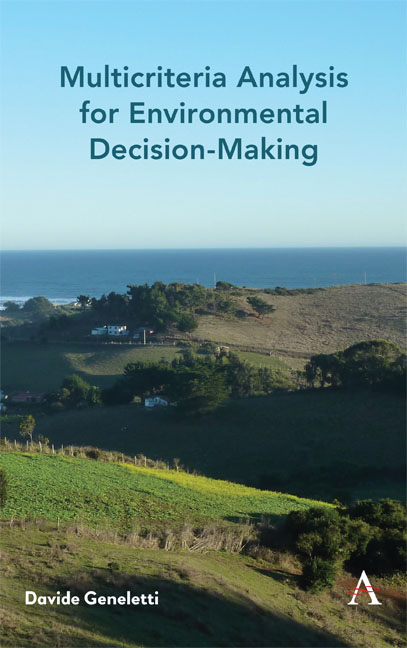Book contents
- Frontmatter
- Contents
- List of Figures
- List of Tables
- Acknowledgements
- List of Author and Contributors
- Introduction
- 1 Principles of Multicriteria Analysis
- 2 A Review of MCA Applications for Nature Conservation
- 3 Landfill Site Selection: Combining Spatial MCA with Stakeholder Analysis
- 4 Protected Area Zoning: Integrating Spatial MCA and Multi-objective Evaluation
- 5 Forest Landscape Restoration: Applying MCA to Design and Compare Options
- 6 Impact Assessment of Ski Areas: Combining GIS Indicators with MCA
- Conclusions
- Annex
- References
- Index
6 - Impact Assessment of Ski Areas: Combining GIS Indicators with MCA
Published online by Cambridge University Press: 16 July 2019
- Frontmatter
- Contents
- List of Figures
- List of Tables
- Acknowledgements
- List of Author and Contributors
- Introduction
- 1 Principles of Multicriteria Analysis
- 2 A Review of MCA Applications for Nature Conservation
- 3 Landfill Site Selection: Combining Spatial MCA with Stakeholder Analysis
- 4 Protected Area Zoning: Integrating Spatial MCA and Multi-objective Evaluation
- 5 Forest Landscape Restoration: Applying MCA to Design and Compare Options
- 6 Impact Assessment of Ski Areas: Combining GIS Indicators with MCA
- Conclusions
- Annex
- References
- Index
Summary
Context
Environmental decision-making problem
Environmental impact assessment (EIA) is the process of predicting and assessing the future consequences on the biophysical and human environment of a project, before approval is granted to that project (Canter 1996). The comparison of alternatives (including the do-nothing option, or zero alternative) and the justification of choices are essential elements of any EIA (Geneletti 2014), as requested by EIA legislations around the world. Alternatives can be represented by different project locations, design and technologies, sizes and capacities, ways to construct or operate the project, mitigation measures and so on. EIA being essentially a process to support choices among options by considering multiple types of impacts, the use of MCA can be beneficial. Indeed, an increasing use of MCA has been reported in EIA, also due to the increase in project complexity, data availability and public participation efforts (Janssen 2001).
At a more strategic decision-making level, the process of strategic environmental assessment (SEA) has been introduced to integrate environmental considerations into policies, plans and programmes and evaluate the interlinkages with economic and social considerations (OECD 2006). SEA too requires the analysis and comparison of possible alternative courses of action, and the identification of the most suitable one(s). For these reasons, MCA has become a prominent approach also to support SEA processes, often in combination with GIS (Gonzalez and Enríquez-de-Salamanca 2018). In SEA alternatives are generally of a strategic nature, representing different ways of achieving the objectives of a policy, plan or programme. For example, the SEA of a spatial plan may compare the effects of different spatial strategies for urban growth (e.g. in Tiitu et al. 2018), or different priorities in land use conversions (see example in Geneletti 2013).
Ski lifts and ski runs are characterized by significant environmental impacts that occur during both the construction and the operation phase, due to activities such as removal of the vegetation cover, surface corrections, piste maintenance and artificial snowing. These activities interfere with fragile high-altitude ecosystems and habitats, and may affect slope stability and water resources. The demand for new skiing facilities has increased steadily in the Alps, fuelled by the reduced availability of snow at existing facilities caused by climate change. This raised concerns about the environmental effects of ski infrastructures.
- Type
- Chapter
- Information
- Multicriteria Analysis for Environmental Decision-Making , pp. 79 - 96Publisher: Anthem PressPrint publication year: 2019



